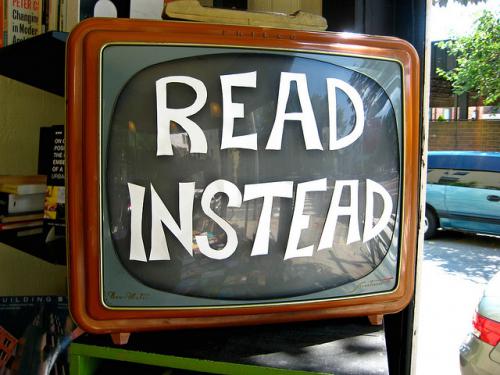
Image Credit:
"Students should be able to both read critically and write functionally, no matter what the medium" (William Kist).
Last semester, I gave a presentation to a class of new Rhetoric and Writing instructors on my "Disability in Pop Culture" class proposal, experiences, and syllabus. Professor Mark Longaker introduced my class as one that works with disability and new media. Although I hadn’t thought of it that way, I realized that my pedagogy most definitely incorporates not only disability theory but also “new” media: whether within my lesson plans and clips pertaining to rhetoric/disability, in the design of my course—with our PbWorks wiki platform, or with the final major assignment I had students write: a multimodal argument. I was apprehensive about assigning this type of new media writing project, but, fortunately, resources abound. This blog post offers some of those resources I drew from and shares my method for assessing my students’ projects.
I have been working with The Journal of Undergraduate Multimedia Projects for over two years now, in a variety of positions, and this work served as my primary resource. The website includes information on the students’ project assignments and on the course. Professors often share their class websites, which means that this journal becomes a pedagogical resource as well as a publication venue. Professor Tanya Rodrigue’s class website inspired me to create a YouTube channel for my own class—even though my multimodal assignment prompt did not restrict the shape of the project to videos (as you can see from the links on the left of our homepage). From Rodrigue's class Tumblr, I came across a helpful article, “Between Modes: Assessing Student New Media Compositions.” I also drew on assignment descriptions and prompts from Professor Justin Hodgson and Scott Nelson.
The National Council of Teachers of English has a “Position Statement on Multimodal Literacies” including statements such as Kist’s, which begins this blog post. Another quote that I took to heart and found exemplified in a TED talk by a 12-year-old was:
"In digital forms, students, even very young students, are often more literate in the technical aspects of digital production than many of their teachers. Many students are frequently exposed to popular technologies, have the leisure time to experiment with their own production, develop the social connections that encourage peer teaching and learning, and may have access to more advanced technology than is available at school. The 'definitions' of multi-modal composing may be written by educators, but they will most likely have first been pioneered by these young people."
Hence, I strongly encouraged my students to collaborate on these projects, to learn from each other, and I happily learned from them. Working in the Digital Writing and Research Labs also means that I had our Visual Media Specialist, Scott Nelson, for support. He came to one of my classes and led an iMovie workshop; he also addressed copyright flags and takedowns on YouTube. Thanks to all of these resources, I felt much more confident about assigning this multimodal project; I also planned for three weeks of class time so students could work together. This time helped alleviate the concerns of the “low-tech” students who were anxious about this project. All of my students proved to have a tech-savviness that they (in some cases) did not know they had. Most were excited about writing in multiple modes. In short, they all relied upon/developed their digital literacy skills.
Teaching and assessing student work via The Learning Record portfolio system (which I explain more in-depth in previous blogs and lesson plans) allows me to assess work not solely based on the final technological project, but on how well it meets the requirements of the assignment, shows development and research into writing in new digital modes, and effectively presents an argument.
After the revision stage, I commented on student progress by synthesizing the comments of three of their peers on how persuasive the project was and whether the revisions following peer review were substantial. The instructions were as follows:
If you have reviewed this project during peer review, answer both questions below.
If this is your first time viewing the project, only answer the second question.
1. Did your peer substantially revise the project? Or, did your peer attend to your feedback and improve the overall project? What improvements stood out and were effective? What still needs improvement?
2. Were you persuaded by the argument? Describe how the argument persuaded you to think or feel a certain way. Or, does it successfully convince you to do something? How did the elements of rhetoric (logos, ethos, and pathos) work to persuade you? Or, how did a lack of attention to certain rhetorical elements (logos, ethos, and/or pathos) result in an unconvincing argument?
This method proved effective because it allowed me to see common threads in feedback and to elaborate on points where students left off. Following the advice of Madeleine Sorapure in “Between Modes: Assessing Student New Media Compositions,” I evaluated projects not only on how well they met the requirements of the assignment, but also on how well they created rhetorical impact via “productive tension” between modes (from the visual, to the textual, to the auditory). In sum, my evaluations via the Learning Record grading system strove to avoid imposing a method of assessment from print essays and, rather, to connect evaluation to “everything else in the course, from the assignments themselves to the readings, the class activities, and the software we use” (Sorapure 2). In my classes, the course goals for development in research, the writing process, presentation, argumentation, and digital literacy all came together in this final project--allowing students to display their skills and to work through the essential learning dimension of confidence and independence.
Further Reading:
Remixing Composition: A History of Multimodal Writing Pedagogy by Jason Palmeri

